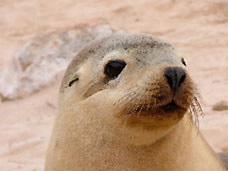Australian Sea Lion

Description
The Australian Sea Lion, Neophoca cinerea is a sexually dimorphic species with the adult males up to twice the weight and length of the female. Both sexes have stocky bodies, a large head and short narrow flippers. Apart from size, the sexes are easily identified by coat colour. The male is dark brown with mane-like yellow areas on the neck and top of the head. The females are silver grey to fawn on the back and creamy coloured underneath. Pups are born with a chocolate brown fur, which is lost after the first moulting phase.
Distribution, Habitat and Status
This species is endemic to Australian waters and breeds on at least 50 islands off the coast of Western Australia and South Australia. They prefer sandy beaches, usually in isolated bays and sheltered areas. One such site on Kangaroo Island off South Australia has become a popular tourist attraction. Australian Sea Lion numbers are relatively small compared to other seals in the area and like most it suffered heavily during the 19th century sealing period with many colonies being wiped out. It is protected by Australian State and Federal government legislation and listed as rare by the IUCN.
Food and Feeding
Their diet is poorly known but probably includes a variety of fish and invertebrates such as octopus and squid. There is some suggestion that they occasionally take penguins.
Breeding
Australian Sea Lions form loose associations within the breeding colonies. Males do not form harems but will guard and then mate with individual females in turn. Timing of the birth of pups is not the same at each site. Young can be born anytime from January to June after a gestation period of about 12 months. Despite the fact that females give birth to only one young and may not breed again for two to three years, pup mortality is high in the first six months after birth.
 Deep Sea Crabs
Deep Sea Crabs